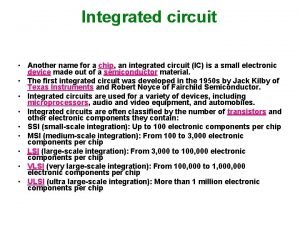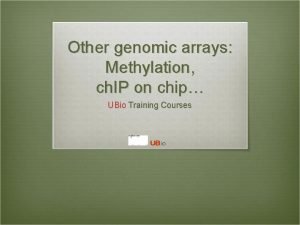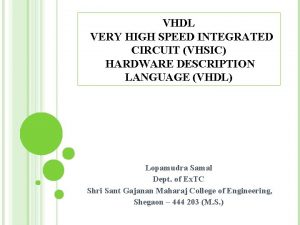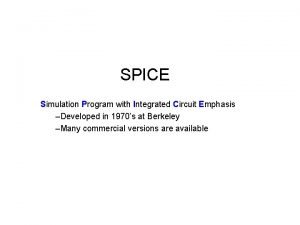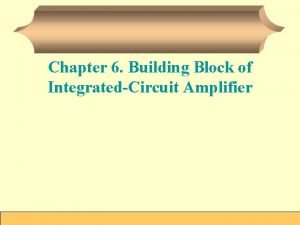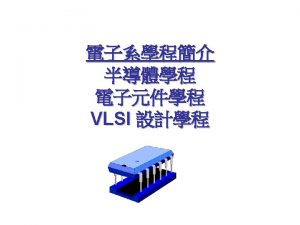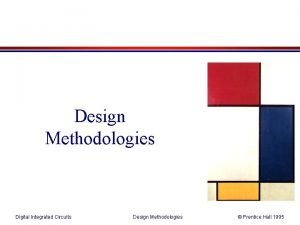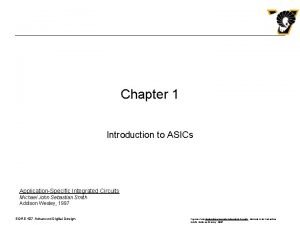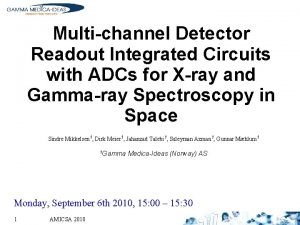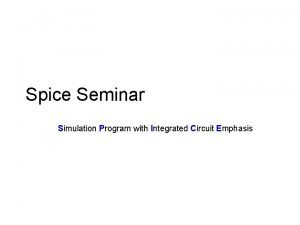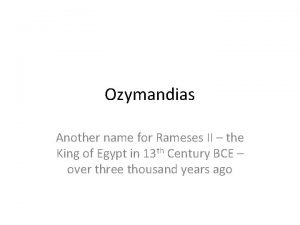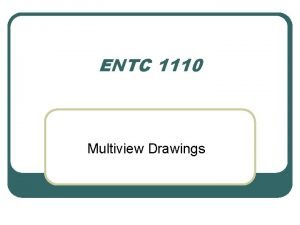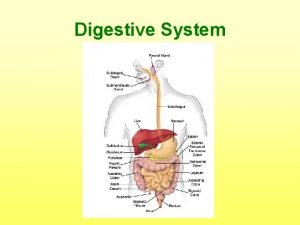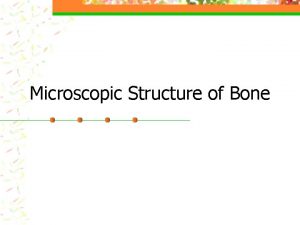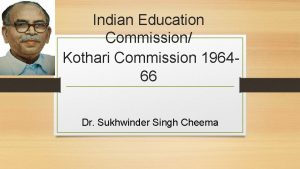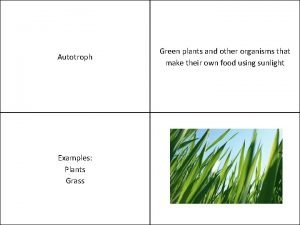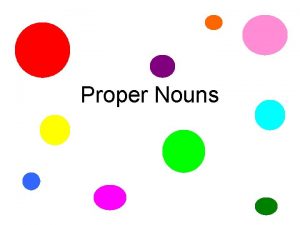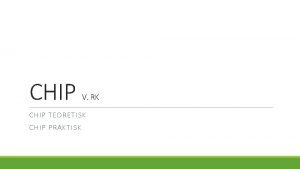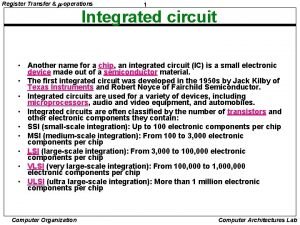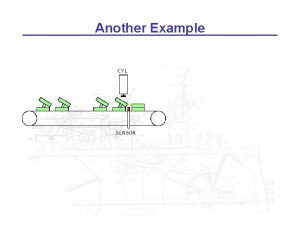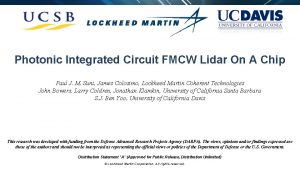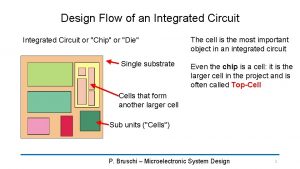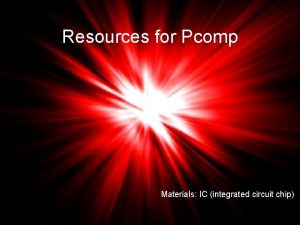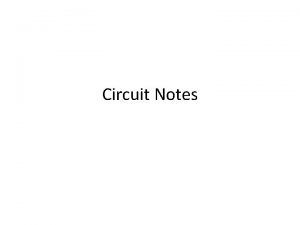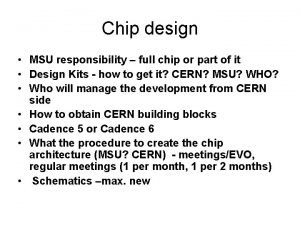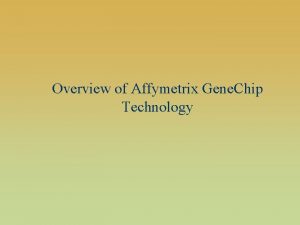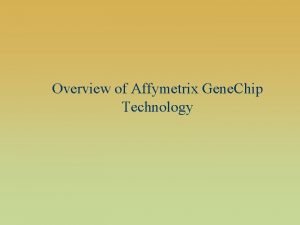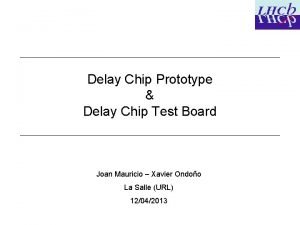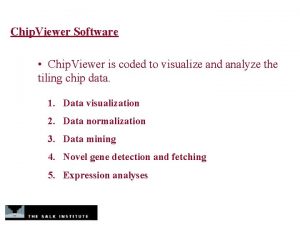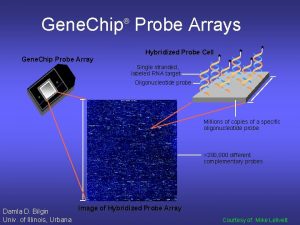Integrated circuit Another name for a chip an














































- Slides: 46

Integrated circuit • Another name for a chip, an integrated circuit (IC) is a small electronic device made out of a semiconductor material. • The first integrated circuit was developed in the 1950 s by Jack Kilby of Texas Instruments and Robert Noyce of Fairchild Semiconductor. • Integrated circuits are used for a variety of devices, including microprocessors, audio and video equipment, and automobiles. • Integrated circuits are often classified by the number of transistors and other electronic components they contain: • SSI (small-scale integration): Up to 100 electronic components per chip • MSI (medium-scale integration): From 100 to 3, 000 electronic components per chip • LSI (large-scale integration): From 3, 000 to 100, 000 electronic components per chip • VLSI (very large-scale integration): From 100, 000 to 1, 000 electronic components per chip • ULSI (ultra large-scale integration): More than 1 million electronic components per chip

REGISTER TRANSFER AND MICROOPERATIONS • Register Transfer Language • Register Transfer • Bus and Memory Transfers • Arithmetic Microoperations • Logic Microoperations • Shift Microoperations • Arithmetic Logic Shift Unit

SIMPLE DIGITAL SYSTEMS • Combinational and sequential circuits (learned in Chapters 1 and 2) can be used to create simple digital systems. • These are the low-level building blocks of a digital computer. • Simple digital systems are frequently characterized in terms of – the registers they contain, and – the operations that they perform. • Typically, – What operations are performed on the data in the registers – What information is passed between registers

Register Transfer Language MICROOPERATIONS (1) • The operations on the data in registers are called microoperations. • The functions built into registers are examples of microoperations – – – Shift Load Clear Increment …

Register Transfer Language MICROOPERATION (2) An elementary operation performed (during one clock pulse), on the information stored in one or more registers Registers (R) ALU (f) 1 clock cycle R f(R, R) f: shift, load, clear, increment, add, subtract, complement, and, or, xor, …

Register Transfer Language ORGANIZATION OF A DIGITAL SYSTEM • Definition of the (internal) organization of a computer - Set of registers and their functions - Microoperations set Set of allowable microoperations provided by the organization of the computer - Control signals that initiate the sequence of microoperations (to perform the functions)

Register Transfer Language REGISTER TRANSFER LEVEL • Viewing a computer, or any digital system, in this way is called the register transfer level • This is because we’re focusing on – The system’s registers – The data transformations in them, and – The data transfers between them.

Register Transfer Language REGISTER TRANSFER LANGUAGE • Rather than specifying a digital system in words, a specific notation is used, register transfer language • For any function of the computer, the register transfer language can be used to describe the (sequence of) microoperations • Register transfer language – A symbolic language – A convenient tool for describing the internal organization of digital computers – Can also be used to facilitate the design process of digital systems.

Register Transfer Language DESIGNATION OF REGISTERS • Registers are designated by capital letters, sometimes followed by numbers (e. g. , A, R 13, IR) • Often the names indicate function: – MAR – PC – IR - memory address register - program counter - instruction register • Registers and their contents can be viewed and represented in various ways – A register can be viewed as a single entity: MAR – Registers may also be represented showing the bits of data they contain

Register Transfer Language DESIGNATION OF REGISTERS • Designation of a register - portion of a register - a bit of a register • Common ways of drawing the block diagram of a register Showing individual bits Register R 1 15 R 2 Numbering of bits 7 0 6 5 15 4 3 2 1 8 7 PC(H) Subfields 0 0 PC(L)

Register Transfer REGISTER TRANSFER • Copying the contents of one register to another is a register transfer • A register transfer is indicated as R 2 R 1 – In this case the contents of register R 2 are copied (loaded) into register R 1 – A simultaneous transfer of all bits from the source R 1 to the destination register R 2, during one clock pulse – Note that this is a non-destructive; i. e. the contents of R 1 are not altered by copying (loading) them to R 2

Register Transfer REGISTER TRANSFER • A register transfer such as R 3 R 5 Implies that the digital system has – the data lines from the source register (R 5) to the destination register (R 3) – Parallel load in the destination register (R 3) – Control lines to perform the action

Register Transfer CONTROL FUNCTIONS • Often actions need to only occur if a certain condition is true • This is similar to an “if” statement in a programming language • In digital systems, this is often done via a control signal, called a control function – If the signal is 1, the action takes place • This is represented as: P: R 2 R 1 Which means “if P = 1, then load the contents of register R 1 into register R 2”, i. e. , if (P = 1) then (R 2 R 1)

Register Transfer HARDWARE IMPLEMENTATION OF CONTROLLED TRANSFERS Implementation of controlled transfer P: R 2 R 1 Block diagram Control Circuit Load P R 2 Clock n R 1 t Timing diagram t+1 Clock Load Transfer occurs here • The same clock controls the circuits that generate the control function and the destination register • Registers are assumed to use positive-edge-triggered flip-flops

Register Transfer SIMULTANEOUS OPERATIONS • If two or more operations are to occur simultaneously, they are separated with commas P: R 3 R 5, MAR IR • Here, if the control function P = 1, load the contents of R 5 into R 3, and at the same time (clock), load the contents of register IR into register MAR

Register Transfer BASIC SYMBOLS FOR REGISTER TRANSFERS Symbols Capital letters & numerals Parentheses () Arrow Colon : Comma , Description Examples Denotes a register MAR, R 2 Denotes a part of a register R 2(0 -7), R 2(L) Denotes transfer of information Denotes termination of control function Separates two micro-operations R 2 R 1 P: A B, B A

Register Transfer CONNECTING REGISTRS • In a digital system with many registers, it is impractical to have data and control lines to directly allow each register to be loaded with the contents of every possible other registers • To completely connect n registers n(n-1) lines • O(n 2) cost – This is not a realistic approach to use in a large digital system • Instead, take a different approach • Have one centralized set of circuits for data transfer – the bus • Have control circuits to select which register is the source, and which is the destination

Bus and Memory Transfers BUS AND BUS TRANSFER Bus is a path(of a group of wires) over which information is transferred, from any of several sources to any of several destinations. From a register to bus: BUS R Register A Register B Register C Register D Bus lines Register A 1 2 3 4 Register B 1 2 3 4 B 1 C 1 D 1 0 4 x 1 MUX Register C 1 2 3 4 B 2 C 2 D 2 0 4 x 1 MUX Register D 1 2 3 4 B 3 C 3 D 3 0 x select y 4 -line bus 4 x 1 MUX B 4 C 4 D 4 0 4 x 1 MUX

Bus and Memory Transfers TRANSFER FROM BUS TO A DESTINATION REGISTER Bus lines Reg. R 0 Reg. R 1 Reg. R 2 D 0 D 1 D 2 D 3 2 x 4 Decoder z Select w Reg. R 3 Load E (enable) Three-State Bus Buffers Output Y=A if C=1 High-impedence if C=0 Normal input A Control input C Bus line with three-state buffers Bus line for bit 0 A 0 B 0 C 0 D 0 Select Enable S 0 S 1 0 1 2 3

Bus and Memory Transfers BUS TRANSFER IN RTL • Depending on whether the bus is to be mentioned explicitly or not, register transfer can be indicated as either R 2 R 1 or BUS R 1, R 2 BUS • In the former case the bus is implicit, but in the latter, it is explicitly indicated

Bus and Memory Transfers MEMORY (RAM) • Memory (RAM) can be thought as a sequential circuits containing some number of registers • These registers hold the words of memory • Each of the r registers is indicated by an address • These addresses range from 0 to r-1 • Each register (word) can hold n bits of data • Assume the RAM contains r = 2 k words. It needs the following – – – n data input lines n data output lines k address lines A Read control line A Write control line data input lines n address lines k Read RAM unit Write n data output lines

Bus and Memory Transfers MEMORY TRANSFER • Collectively, the memory is viewed at the register level as a device, M. • Since it contains multiple locations, we must specify which address in memory we will be using • This is done by indexing memory references • Memory is usually accessed in computer systems by putting the desired address in a special register, the Memory Address Register (MAR, or AR) • When memory is accessed, the contents of the MAR get sent to the memory unit’s address lines M AR Read Memory unit Data out Write Data in

Bus and Memory Transfers MEMORY READ • To read a value from a location in memory and load it into a register, the register transfer language notation looks like this: R 1 M[MAR] • This causes the following to occur – The contents of the MAR get sent to the memory address lines – A Read (= 1) gets sent to the memory unit – The contents of the specified address are put on the memory’s output data lines – These get sent over the bus to be loaded into register R 1

Bus and Memory Transfers MEMORY WRITE • To write a value from a register to a location in memory looks like this in register transfer language: M[MAR] R 1 • This causes the following to occur – The contents of the MAR get sent to the memory address lines – A Write (= 1) gets sent to the memory unit – The values in register R 1 get sent over the bus to the data input lines of the memory – The values get loaded into the specified address in the memory

Bus and Memory Transfers SUMMARY OF R. TRANSFER MICROOPERATIONS A B Transfer content of reg. B into reg. A AR DR(AD) Transfer content of AD portion of reg. DR into reg. AR A constant Transfer a binary constant into reg. A ABUS R 1, Transfer content of R 1 into bus A and, at the same time, R 2 ABUS AR DR M[R] M transfer content of bus A into R 2 Address register Data register Memory word specified by reg. R Equivalent to M[AR] DR M Memory read operation: transfers content of memory word specified by AR into DR Memory write operation: transfers content of DR into memory word specified by AR

Arithmetic Microoperations MICROOPERATIONS • Computer system microoperations are of four types: - Register transfer microoperations - Arithmetic microoperations - Logic microoperations - Shift microoperations

Arithmetic Microoperations ARITHMETIC MICROOPERATIONS • The basic arithmetic microoperations are – – Addition Subtraction Increment Decrement • The additional arithmetic microoperations are – – Add with carry Subtract with borrow Transfer/Load etc. … Summary of Typical Arithmetic Micro-Operations R 3 R 1 + R 2 R 3 R 1 - R 2’ R 2’+ 1 R 3 R 1 + R 2’+ 1 R 1 - 1 Contents of R 1 plus R 2 transferred to R 3 Contents of R 1 minus R 2 transferred to R 3 Complement the contents of R 2 2's complement the contents of R 2 (negate) subtraction Increment Decrement

Arithmetic Microoperations BINARY ADDER / SUBTRACTOR / INCREMENTER Binary Adder-Subtractor Binary Incrementer

Arithmetic Microoperations ARITHMETIC CIRCUIT Cin S 1 S 0 A 0 X 0 S 1 S 0 0 4 x 1 1 MUX 2 3 B 0 A 1 S 0 0 4 x 1 1 MUX 2 3 A 2 S 1 S 0 0 4 x 1 1 MUX 2 3 B 2 A 3 B 3 0 S 0 0 0 1 1 Cin 0 1 0 1 FA X 1 B 1 S 1 0 0 1 1 Y 0 C 0 1 Y B B B’ B’ 0 0 1 1 Output D=A+B+1 D = A + B’+ 1 D=A+1 D=A-1 D=A S 1 S 0 0 4 x 1 1 MUX 2 3 D 0 C 1 D 1 FA Y 1 C 2 X 2 C 2 D 2 FA Y 2 C 3 X 3 C 3 D 3 FA Y 3 C 4 Microoperation Add with carry Subtract with borrow Subtract Transfer A Increment A Decrement A Transfer A Cout

Logic Microoperations LOGIC MICROOPERATIONS • Specify binary operations on the strings of bits in registers – Logic microoperations are bit-wise operations, i. e. , they work on the individual bits of data – useful for bit manipulations on binary data – useful for making logical decisions based on the bit value • There are, in principle, 16 different logic functions that can be defined over two binary input variables A 0 0 1 1 B F 0 0 0 1 0 F 1 0 0 0 1 F 2 … F 13 0 … 1 1 … 0 0 … 1 F 14 1 1 1 0 F 15 1 1 • However, most systems only implement four of these – AND ( ), OR ( ), XOR ( ), Complement/NOT • The others can be created from combination of these

Logic Microoperations LIST OF LOGIC MICROOPERATIONS • List of Logic Microoperations - 16 different logic operations with 2 binary vars. n - n binary vars → 2 2 functions • Truth tables for 16 functions of 2 variables and the corresponding 16 logic micro-operations x 0011 y 0101 0000 0001 0010 0011 0100 0101 0110 0111 1000 1001 1010 1011 1100 1101 1110 1111 Boolean Function F 0 = 0 F 1 = xy F 2 = xy' F 3 = x F 4 = x'y F 5 = y F 6 = x y F 7 = x + y F 8 = (x + y)' F 9 = (x y)' F 10 = y' F 11 = x + y' F 12 = x' F 13 = x' + y F 14 = (xy)' F 15 = 1 Micro. Name Operations F 0 Clear F A B AND F A B’ F A Transfer A F A’ B F B Transfer B F A B Exclusive-OR F A B OR F A B)’ NOR F (A B)’ Exclusive-NOR F B’ Complement B F A B F A’ Complement A F A’ B F (A B)’ NAND F all 1's Set to all 1's

Logic Microoperations HARDWARE IMPLEMENTATION OF LOGIC MICROOPERATIONS Ai Bi 0 1 4 X 1 MUX Fi 2 3 Select S 1 S 0 Function table S 1 0 0 1 1 S 0 0 1 Output F=A B F = A B F=A B F = A’ -operation AND OR XOR Complement

Logic Microoperations APPLICATIONS OF LOGIC MICROOPERATIONS • Logic microoperations can be used to manipulate individual bits or a portions of a word in a register • Consider the data in a register A. In another register, B, is bit data that will be used to modify the contents of A – – – – Selective-set Selective-complement Selective-clear Mask (Delete) Clear Insert Compare. . . A A+B A A B A A • B’ A A • B A A B A (A • B) + C A A B

Logic Microoperations SELECTIVE SET • In a selective set operation, the bit pattern in B is used to set certain bits in A 1100 1010 1110 At B At+1 (A A + B) • If a bit in B is set to 1, that same position in A gets set to 1, otherwise that bit in A keeps its previous value

Logic Microoperations SELECTIVE COMPLEMENT • In a selective complement operation, the bit pattern in B is used to complement certain bits in A 1100 1010 At B 0110 At+1 (A A B) • If a bit in B is set to 1, that same position in A gets complemented from its original value, otherwise it is unchanged

Logic Microoperations SELECTIVE CLEAR • In a selective clear operation, the bit pattern in B is used to clear certain bits in A 1100 1010 At B 0100 At+1 (A A B’) • If a bit in B is set to 1, that same position in A gets set to 0, otherwise it is unchanged

Logic Microoperations MASK OPERATION • In a mask operation, the bit pattern in B is used to clear certain bits in A 1100 1010 At B 1000 At+1 (A A B) • If a bit in B is set to 0, that same position in A gets set to 0, otherwise it is unchanged

Logic Microoperations CLEAR OPERATION • In a clear operation, if the bits in the same position in A and B are the same, they are cleared in A, otherwise they are set in A 1100 1010 At B 0110 At+1 (A A B)

Logic Microoperations INSERT OPERATION • An insert operation is used to introduce a specific bit pattern into A register, leaving the other bit positions unchanged • This is done as – A mask operation to clear the desired bit positions, followed by – An OR operation to introduce the new bits into the desired positions – Example » Suppose you wanted to introduce 1010 into the low order four bits of A: 1101 1000 1011 0001 A (Original) 1101 1000 1011 1010 A (Desired) » 1101 1111 1101 0000 1101 1000 1111 1000 0000 1011 1111 1011 0000 0000 1010 A (Original) Mask A (Intermediate) Added bits A (Desired)

Shift Microoperations SHIFT MICROOPERATIONS • There are three types of shifts – Logical shift – Circular shift – Arithmetic shift • What differentiates them is the information that goes into the serial input • A right shift operation Serial input • A left shift operation Serial input

Shift Microoperations LOGICAL SHIFT • In a logical shift the serial input to the shift is a 0. • A right logical shift operation: 0 • A left logical shift operation: • In a Register Transfer Language, the following notation is used – shl for a logical shift left – shr for a logical shift right – Examples: » R 2 shr R 2 » R 3 shl R 3 0

Shift Microoperations CIRCULAR SHIFT • In a circular shift the serial input is the bit that is shifted out of the other end of the register. • A right circular shift operation: • A left circular shift operation: • In a RTL, the following notation is used – cil for a circular shift left – cir for a circular shift right – Examples: » R 2 cir R 2 » R 3 cil R 3

Shift Microoperations ARITHMETIC SHIFT • An arithmetic shift is meant for signed binary numbers (integer) • An arithmetic left shift multiplies a signed number by two • An arithmetic right shift divides a signed number by two • The main distinction of an arithmetic shift is that it must keep the sign of the number the same as it performs the multiplication or division • A right arithmetic shift operation: sign bit • A left arithmetic shift operation: sign bit 0

Shift Microoperations ARITHMETIC SHIFT • An left arithmetic shift operation must be checked for the overflow 0 sign bit V Before the shift, if the leftmost two bits differ, the shift will result in an overflow • In a RTL, the following notation is used – ashl for an arithmetic shift left – ashr for an arithmetic shift right – Examples: » R 2 ashr R 2 » R 3 ashl R 3

Shift Microoperations HARDWARE IMPLEMENTATION OF SHIFT MICROOPERATIONS Serial input (IR) 0 for shift right (down) Select 1 for shift left (up) S 0 1 MUX H 0 MUX H 1 MUX H 2 MUX H 3 A 0 A 1 S A 2 0 1 A 3 S 0 1 Serial input (IL)

Shift Microoperations ARITHMETIC LOGIC SHIFT UNIT S 3 S 2 S 1 S 0 Ci Arithmetic D i Circuit 0 1 2 3 Ci+1 Bi Ai Ai-1 Ai+1 S 3 0 0 0 1 1 S 2 0 0 0 0 1 1 0 1 S 0 0 0 1 0 1 0 1 1 0 0 0 1 1 X X Select Logic Circuit 4 x 1 MUX Fi Ei shr shl Cin 0 1 0 1 X X X Operation F=A+1 F=A+B+1 F = A + B’+ 1 F=A-1 F=A B F = A B F=A B F = A’ F = shr A F = shl A Function Transfer A Increment A Addition Add with carry Subtract with borrow Subtraction Decrement A Transfer. A AND OR XOR Complement A Shift right A into F Shift left A into F
 Another name for a computer chip is
Another name for a computer chip is Methylation & chip-on-chip microarray platform
Methylation & chip-on-chip microarray platform Harris burdick pictures
Harris burdick pictures Name three line segments
Name three line segments Very high speed integrated circuit
Very high speed integrated circuit Spice (simulation program with integrated circuit emphasis)
Spice (simulation program with integrated circuit emphasis) Monolithic ic
Monolithic ic Building blocks of integrated-circuit amplifiers
Building blocks of integrated-circuit amplifiers Simbol ic
Simbol ic Ic ssi
Ic ssi Digital integrated circuits
Digital integrated circuits Application specific integrated circuits
Application specific integrated circuits Readout integrated circuit
Readout integrated circuit Shanghai integrated circuit industry
Shanghai integrated circuit industry Munpf
Munpf Ic integrated circuit pertama kali ditemukan pada
Ic integrated circuit pertama kali ditemukan pada Circuit in parallel vs series
Circuit in parallel vs series Parallel circuit with 3 bulbs
Parallel circuit with 3 bulbs Parallel circuit circuit construction kit
Parallel circuit circuit construction kit Series vs parallel circut
Series vs parallel circut What is an incomplete circuit
What is an incomplete circuit Parallel circuit short circuit
Parallel circuit short circuit Similarities of parallel and series circuits
Similarities of parallel and series circuits Circulatory system labeled
Circulatory system labeled Current in a parallel circuit
Current in a parallel circuit Current cash debt coverage ratio
Current cash debt coverage ratio What is ozymandias another name for?
What is ozymandias another name for? Another name for income statement
Another name for income statement Six principal view
Six principal view Another name for small intestine
Another name for small intestine Main idea of photosynthesis
Main idea of photosynthesis Osseous
Osseous What is banner headline in newspaper
What is banner headline in newspaper Another name for rain
Another name for rain Another name for customer
Another name for customer Kothari commission report
Kothari commission report What is another name for the representative elements
What is another name for the representative elements Autotroph grass
Autotroph grass Biotic community is another name for____
Biotic community is another name for____ Proper noun girl names
Proper noun girl names Iso 22301 utbildning
Iso 22301 utbildning Novell typiska drag
Novell typiska drag Nationell inriktning för artificiell intelligens
Nationell inriktning för artificiell intelligens Returpilarna
Returpilarna Varför kallas perioden 1918-1939 för mellankrigstiden?
Varför kallas perioden 1918-1939 för mellankrigstiden? En lathund för arbete med kontinuitetshantering
En lathund för arbete med kontinuitetshantering Personalliggare bygg undantag
Personalliggare bygg undantag
